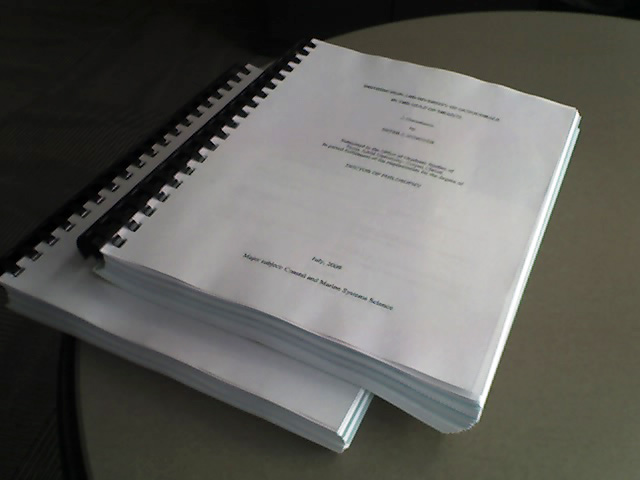Construction dissertation guide part 1 - Choosing a subject and preparing a proposal
This is part of a series of Construction Dissertation Guides for students. Click here for the whole series.
Contents |
[edit] Subject
The first, and perhaps most difficult step is deciding the subject. The subject will usually be inspired by an aspect of your studies that you feel particularly interested in, although it will need to be informed by a lot of research, as well as discussing options with lecturers and looking at past dissertation subjects.
The subject will need to be based around a problem of some kind that your research will be able to explore in depth. It could be part of a course module that you have found particularly interesting, or, if you have worked in the industry, there could be something you experienced during this time that you could use to build ideas.Read the industry press and news sites to keep informed about what is energising debate.
Once you have a basic idea, set about narrowing it down to a specific aspect of the problem that is likely to be manageable. Read around the subject and think about which part is the most interesting or suitable. Make sure you select a subject that will allow you to gain access existing literature and to sources of data to inform your research.
[edit] Dissertation proposal
The dissertation proposal is a short document produced once the subject has been selected (although the precise focus or scope of the research will still be refined after this point). It may contain the following sections:
[edit] Working title
A concise subject summary and focus for the research. The purpose of the title is to identify in plain language what is being studied.
[edit] Purpose/rationale
An overview of the problem to be researched and the main issues to be addressed. This is similar to what will later become the abstract.
[edit] Aim
Usually one sentence that condenses the overall purpose of the research and what it hopes to achieve.
[edit] Objectives
These are sub-aims that can be listed as an extension of the overarching aim statement. These clarify the aspects of the study that will be addressed.
[edit] Hypothesis
This is a theory that your dissertation should set out to test or validate. The conclusion will aim to determine whether the hypothesis has been proven or not. If the subject of your dissertation cannot be expressed as a hypothesis then formulate some key questions which provide the research with direction.
[edit] Outline methodology
This briefly describes the means by which you will carry out your research for example, literature review, surveys, site visits, interviews, and so on.
[edit] Initial references
This lists the details of the main reference sources that will be used. At this stage it is sufficient to include those which have informed the research and led to the proposal.
[edit] Work plan
A simple chart or timetable that highlights key points of progress over the following weeks.
Continue to the next stage: Literature review.
Featured articles and news
Delivering for tenants; National Retrofit Hub
New report offers recommendations to strengthen energy efficiency standards to protect private renters.
Government consultations for the summer of 2025
A year of Labour, past and present consultations on the environment, the built environment, training and tax.
CMA competitiveness probe of major housing developers
100 million affordable housing contributions committed with further consultation published.
Homes England supports Greencore Homes
42 new build affordable sustainable homes in Oxfordshire.
Zero carbon social housing: unlocking brownfield potential
Seven ZEDpod strategies for brownfield housing success.
CIOB report; a blueprint for SDGs and the built environment
Pairing the Sustainable Development Goals with projects.
Types, tests, standards and fires relating to external cladding
Brief descriptions with an extensive list of fires for review.
Latest Build UK Building Safety Regime explainer published
Key elements in one short, now updated document.
UKGBC launch the UK Climate Resilience Roadmap
First guidance of its kind on direct climate impacts for the built environment and how it can adapt.
CLC Health, Safety and Wellbeing Strategy 2025
Launched by the Minister for Industry to look at fatalities on site, improving mental health and other issues.
One of the most impressive Victorian architects. Book review.
Common Assessment Standard now with building safety
New CAS update now includes mandatory building safety questions.
RTPI leader to become new CIOB Chief Executive Officer
Dr Victoria Hills MRTPI, FICE to take over after Caroline Gumble’s departure.
Social and affordable housing, a long term plan for delivery
The “Delivering a Decade of Renewal for Social and Affordable Housing” strategy sets out future path.
A change to adoptive architecture
Effects of global weather warming on architectural detailing, material choice and human interaction.
The proposed publicly owned and backed subsidiary of Homes England, to facilitate new homes.
How big is the problem and what can we do to mitigate the effects?
Overheating guidance and tools for building designers
A number of cool guides to help with the heat.
The UK's Modern Industrial Strategy: A 10 year plan
Previous consultation criticism, current key elements and general support with some persisting reservations.
Building Safety Regulator reforms
New roles, new staff and a new fast track service pave the way for a single construction regulator.


























